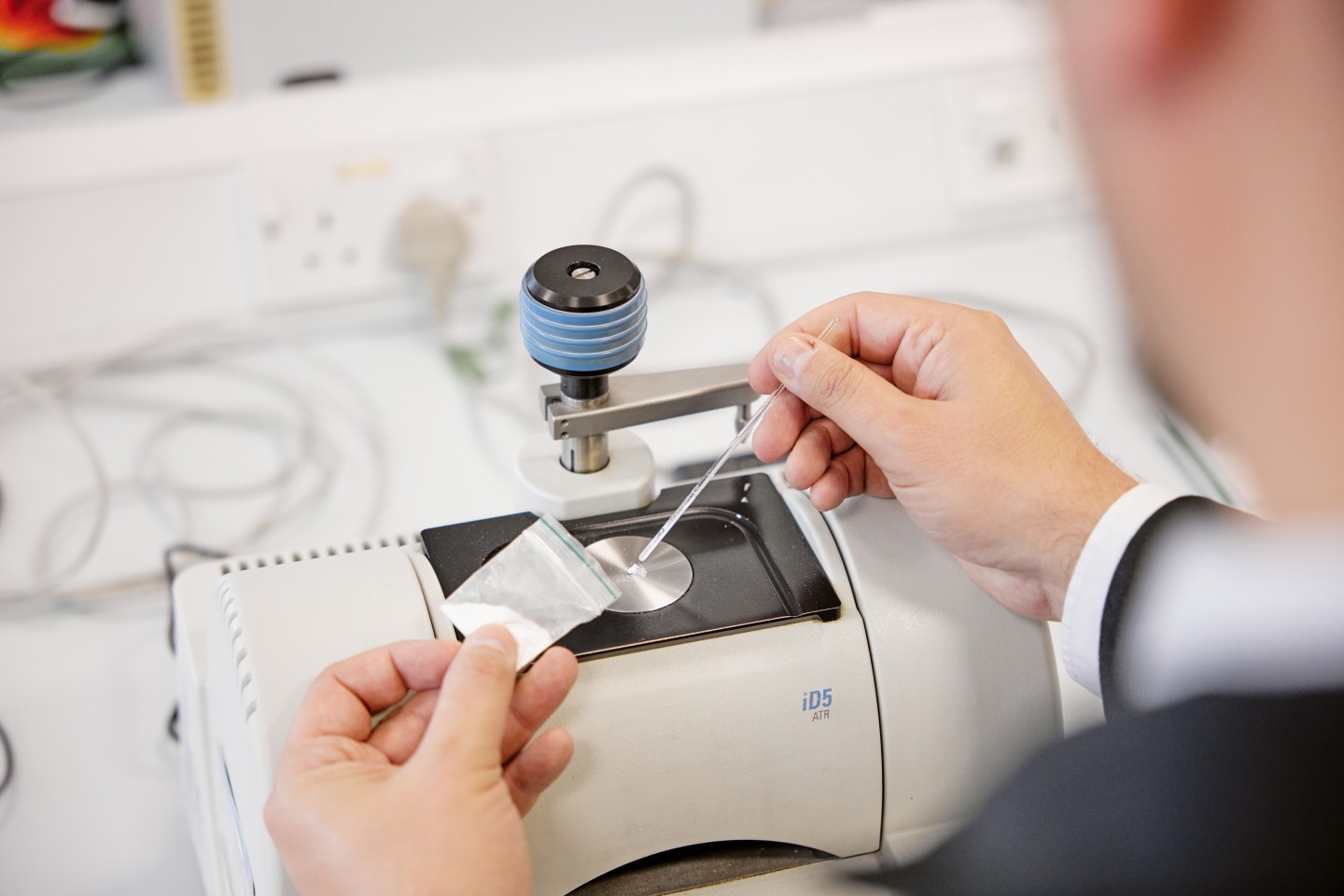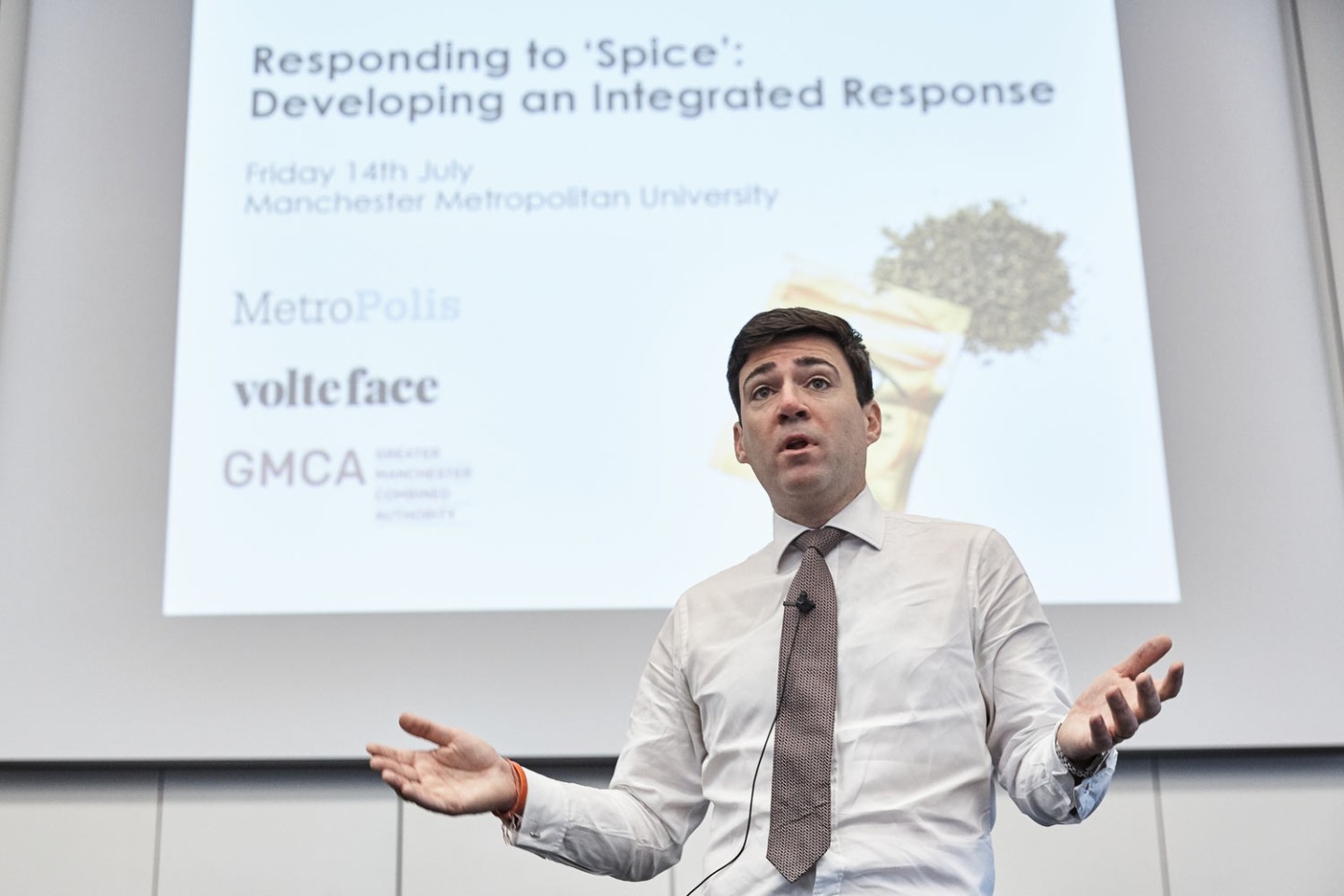
Reducing harm posed by new psychoactive substances
How researchers at Manchester Met have underpinned the city’s cross sector responses to new psychoactive substances through a pioneering detection system.
A global synthetic cannabinoid epidemic
In the 2010s, a global synthetic cannabinoid epidemic found its way to the streets of Manchester.
Most commonly sold in the UK as Spice or Mamba, synthetic cannabinoids are lab-created substances designed to mimic the effects of other drugs, often with much higher potency and a lower street value.
Initially labelled a ‘legal high’, the drug was banned in in 2016, but abuse – and resulting deaths – continued to rise.
A 2017 peak in Manchester city centre saw police respond to 58 Spice-related incidents in a single weekend. Something had to be done.
Fast forward four years and synthetic substances continue to add an extra layer of danger to recreational drug use, and it isn’t just Spice.

New psychoactive substances (NPS), formerly referred to as legal highs, are still easily accessible to the most vulnerable. The key difference, however, is that the authorities and emergency services are now more equipped than ever to combat the problem. A large part of that is down to research.
Tackling the threat
In response to the emergence of NPS and the threat they pose to society, researchers at Manchester Met have pioneered a new system that that allows for their detection.
The testing methods and resulting data offers insights into supply, use trends and ultimately aims to lead to harm reduction.
Using Manchester Met’s facilities, Greater Manchester Police (GMP) are now able to determine the contents of almost any drug. Crucially, they’re able to do it within a couple of hours.
Following years of studies conducted by researchers at the University, the process is now formally embedded as part of GMP’s official proceedings.
For Dr Oliver Sutcliffe and Dr Ryan Mewis, that process has been a long time in the making.
Their research has led to the establishment of The MANchester DRug Analysis and Knowledge Exchange (MANDRAKE) – a licenced scientific resource based at Manchester Met.
Set up in 2017, it represents a partnership between the University and GMP with funding from Greater Manchester Combined Authority (GMCA). It provides the police with non-forensic analysis of drugs.

The Dark Side Of Britain: Spice
Documentary by UniLad, featuring Manchester Met's Dr Oliver Sutcliffe.We were able to identify drugs that were in circulation very quickly – initially within about 24 hours, but now in as little as two hours.
Oliver, who has published 60 papers on the effects of psychoactive substances since 2012, is a senior lecturer at Manchester Met and leads the research group behind MANDRAKE.
He explains how his research coincided with the synthetic epidemic: “I was working on the analysis of controlled drugs around the same time synthetic drugs – “legal highs” – were hitting the market.
“At the beginning, it was just research. Developing new ways of testing. It was very academic based with no outside interest or community link.”
That research was only possible at Manchester Met under specific conditions, as Oliver explains: “We are one of the only universities in the UK with a complete controlled drugs licence.”
Combining humanities and science
However, Oliver identified the need to combine scientific data with that all-important human element and sought to find ways to put his findings to practical use.
“In 2015 I spoke to my colleague Prof Rob Ralphs about how we could combine the humanities with the science. He deserves a lot of credit. I couldn’t have done this without him.”
When the Spice epidemic exploded in 2017, the need to apply Oliver and Rob’s research became more urgent.
“When we had the incidents with Spice in the city centre, there was suddenly a media outcry about Manchester being the Spice capital of the world. The spotlight started to move onto the Mayor’s office and city council. People wanted to know what was going to be done.
“I spoke at a conference that Rob had set up about drug testing. The police attended and ended up coming to see the lab. They brought Spice samples, and we did a longitudinal study over about 18 months.”
The results of the study were fed back to GMP and GMCA, with the data being uploaded to a central network and shared via email – a primitive version of the system that exists today.
That involvement with GMCA would form the basis of what would eventually go on to be the Manchester Drugs Early Warning System, an initiative designed to detect harmful and potentially dangerous substances being used around Greater Manchester.
The first of its kind in the UK, the system now informs 700 frontline healthcare practitioners about substances in circulation, critical incidents and emergency care protocols. It has also streamlined the police’s ability to test harmful substances with a high degree of precision, one of the main reason’s it is now formally embedded into GMP’s protocols.
“We were able to identify drugs that were in circulation very quickly – initially within about 24 hours, but now in as little as two hours.
“On the back of that, we had conversations about formalising it into the early warning system so there was a testing functionality.”
‘We need results now’
Integrating Oliver’s research into the process was a huge step forward. Previously, the police would send a controlled substance to a forensic lab for evidential purposes, a process that could potentially take up to three months.
“The problem with trying to use that process for urgent harm reduction for spikes like April 2017 is that you couldn’t have said let’s wait six weeks to get the results. We needed the results now.”
The lab’s primary function is to assist in harm reduction. It isn’t involved in criminal proceedings.
“The forensic process stays the same, we don’t get involved in anything evidential. We’re involved in critical incidents and intelligence gathering – prevalence data and quality data so we can monitor drug trends and how they’re changing. None of our work gets associated with criminal cases.”
One of those critical incidents occurred in Bury in 2018, when three teenagers were hospitalised after taking what they thought was ecstasy (MDMA tablets). MANDRAKE carried out almost immediate tests on the substances involved.
“The samples arrived at around 2pm. By 4pm, we had all the qualitative data. At 6pm an alert went out. In about four hours we’d been able to do everything.”
The information was passed on to the hospital and the early warning system delivered a safety message to the public. All three teenagers made a full recovery, and no more cases of the substance were reported.
It showed how vital and efficient MANDRAKE’s testing could be in a major incident.


Oliver’s testing with Greater Manchester Police has played a part in helping tackle the misuse of synthetics and in turn protect some of the most vulnerable on the streets of Manchester.
But it isn’t just NPS like Spice that are the problem. Harmful substances can infiltrate their way into other ‘designer drugs’ taken by partygoers.
As a result, Oliver has applied his testing to some of Manchester’s biggest events: Warehouse Project and Manchester Pride. The aim is to identify dangerous and potentially deadly substances, and let people know as early as possible through drug alerts directly to their phones via an app.
Oliver explains how the process works. “Drugs are seized or surrendered by individuals on-site. We’ll collect large samples and transfer them to our lab securely to test the drugs and feed the results back to the police and event organisers. During Pride, we work from five in the afternoon till five in the morning, three days running.”
Safeguarding society
It takes hours of dedication but the potential benefits are huge. The organisers of Warehouse Project estimate that Oliver’s rapid testing has protected 48,624 attendees over five events. An alert at Pride 2018 was shared nationally, with a potential total reach of 40 million people.
The testing carried out revolves around three main checks.
“We’ve got three major flags. Firstly, substances being mis-sold as another substance. For example, we found MDMA crystals at one of the events that actually turned out to be a synthetic opiate called MT45. That opiate is very toxic and very potent. If you consumed that amount thinking it was MDMA, it would have an adverse effect.
“The second thing we look for is something completely novel that we haven’t seen before. If we see something that hasn’t been reported locally, or potentially in the UK, we’ll immediately report it. That’s the great thing about having the lab where it is, we’re able to test it against a massive library.”
Reporting instances of never-before-seen drugs is crucial for frontline medical staff and first responders. By knowing what they’re potentially up against, paramedics stand a better chance of administering the right treatments.
The third flag that Oliver tests for is specifically around ecstasy and its potency, which can vary drastically.
“Ecstasy tablets are probably the most prominent of the drugs that we test. We might normally see around 100-150 mg of MDMA in an ecstasy tablet. But there have been times where we’ve seen 200-250mg and on one shocking occasion tablets containing 300-480mg equivalent to four or five times the standard oral dose were observed. If we see anything that high we’ll raise the alarm.”
Raising that alarm can be the difference between a few people ingesting a harmful substance and a few hundred. But it isn’t just about sending out warnings every time a substance is tested.
“There’s a little bit of pragmatism. It’s all about collecting data. If we don’t need to put an alert out, we won’t put an alert out. That can also be a good thing. Sometimes you can have alert overload.”
That’s not to say that Oliver’s work promotes the ‘safe’ taking of substances. “Of course the safest way to take drugs is to not take them at all,” he says.
There’s a little bit of pragmatism. It’s all about collecting data. If we don’t need to put an alert out, we won’t put an alert out. That can also be a good thing. Sometimes you can have alert overload.
A vision for the future
Currently, there are only a few research groups in the UK that possess the required licenses for the type of testing that Oliver carries out at MANDRAKE. His vision for the future involves a fully connected national network with the ability to share data.
“What I would like to see is a network of likeminded, licensed harm reduction laboratories across England and the devolved nations, co-operating and sharing scientific data to inform users, empower them to engage with welfare services and ultimately save lives.”
The benefit of Oliver’s plan is that no one organisation would have complete control over the testing of controlled substances, or the messaging that accompanies it. More data can be collected locally, and instantly passed on to partners across the nation.
“Rather than having us all over the UK, why can’t you have a network of harm reduction laboratories where they are all plugged in and all sharing data?”
The criminalisation of synthetic drugs has made testing them more cost prohibitive, with only a small number of organisations holding the required licences to handle such substances. Oliver believes this is where collaboration is paramount.
“Ultimately, harm reduction is about bringing all those people together, ditching the egos, and focusing on what’s important. What’s important is safeguarding society.”
Partners and researchers
Lead researcher
-
We are one of the only universities in the UK with a complete controlled drugs licence.
Dr Oliver Sutcliffe






